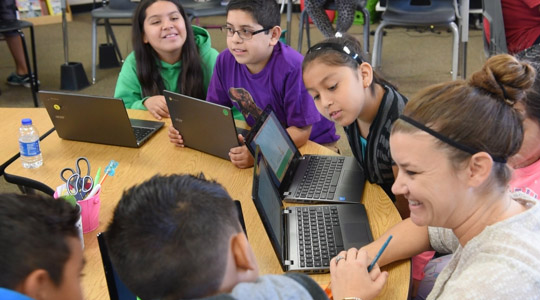
Many ST Math teachers have seen the benefits of incorporating social-emotional learning (SEL) lessons into their math instruction time. Students are more engaged in discussions, have greater empathy for their peers, and can better manage their emotions while persevering through challenging problems.
Driving this personal growth is the ST Math Problem Solving process, which can be used to practice interrelated SEL skills outlined in CASEL’s SEL core competencies.
The Problem Solving Process was developed to make the perception-action cycle (see The Science of ST Math) easier to bring into your classroom. The goal is to get students involved in learning, which requires noticing what is going on in an ST Math puzzle and then starting a cycle of predicting, testing, and analyzing. When the learning is successful, it's connected to what is already known and extends knowledge.
Empowering students to go through the Problem Solving Process when faced with a challenge can improve their problem-solving strategies, curb math anxiety, and hone the SEL skills they’ll need to be successful in future situations.
This first stage of the Problem Solving Process is all about focusing students’ thinking on the problem they’re facing. Start by asking questions like:
Thinking about how to get started when tackling a problem can help with students’ self-awareness and self-management competencies. Students can pause to recognize their feelings, calm themselves, and focus their attention sufficiently so they can effectively participate in learning. Students can also take a moment to hone their goal-setting skills by committing to solve the problem.
To extend SEL during this initial step of the Problem Solving Process, you can use a chart like the one below to help students express how they may be feeling about this particular challenge or their math abilities in general.
After awareness comes action. The Predict and Justify stage uncovers students’ thinking around how they plan to address the problem. Ask questions like:
This second step will begin to touch on the responsible decision-making competency. Students must begin to use reasoning strategies to plan their choice of how to solve the problem. They’ll need to evaluate their options and make effective decisions.
It is crucial to emphasize that there are no mistakes in this stage, just critical thinking. Once an action plan is formed, a student may feel less anxious and even motivated to press on. This can help them be more receptive to the feedback they’re about to receive.
In this stage of the Problem Solving Process, encourage students to observe and process the results of testing their hypotheses. Prompt them to:
The big moment has arrived. Students have noticed and wondered, predicted and justified, and now they’ll get to see what happens. Was their approach correct, or will it need to be adjusted? This is another great opportunity for self-awareness and self-management. As students watch the outcome of their problem-solving approach, they can choose a growth mindset and nurture their math self-beliefs and self-efficacy. They can also practice regulating their emotions and behaviors, show perseverance, and employ delayed gratification.

If students are testing and observing as a class, they may also be able to practice social awareness. While one student or group of students tests their hypothesis, the class can work to understand and observe important social norms, recognize there are diverse approaches to problem solving, and understand that the approaches of others can help to identify new and improved strategies for all. We’ll share an effective way to do this in the next step!
Now, facilitate students in analyzing the feedback and results of what they’ve just tested and observed. Ask questions like:
You can continue to foster social awareness and incorporate relationship skills here by engaging the entire class in academic discourse. Hold a classroom discussion to encourage listening and communication skills. Students can summarize their learning out loud to try and understand what happened in the puzzle and if they were correct or will need to try again. Other students can chime in with differing perspectives and approaches. Exploring the Problem Solving Process through mathematical discourse can help students develop speaking and listening skills and the ability to collaborate to solve problems.
Consider using a Puzzle Talk! This ST Math feature seamlessly allows your class to practice mathematical discourse and problem solving together.
In this final step, stretch students’ thinking! Students are ready to be asked:
Here again, students can practice their responsible decision-making skills. They’ll need to use reasoning strategies to reflect on choices and goals in order to deepen their mathematical understanding. You can also continue to explore these questions as a class to reinforce those relation skills and social awareness competencies.
Finally, after going through the entire Problem Solving Process, students’ self-awareness and self-management skills will be strengthened if they have completed all of the steps thoughtfully and feel ready to do it all again.
We hope this helps you identify different opportunities to practice SEL skills during your ST Math time. With consistent and intentional practice, your students will be on the path to becoming well-rounded critical thinkers who see themselves as capable problem solvers.
For more examples of SEL in elementary mathematics instruction, we encourage you to explore this paper by the CASEL Collaborating States Initiative.
Want a reminder to implement an intentional SEL framework into your math class? Download our Problem Solving Process poster (available in English and Spanish) and our Problem Solving Process bookmark.

Parker Erickson was MIND’s Content and Community Specialist. As a digital storyteller, Parker is passionate about building strong communities through technology and social media. Off the clock, you can find him buried in the latest issue of The New Yorker or experiencing different cultures through food.
Comment